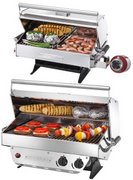A Customer Revives a Dickinson Chesapeake
I have recently read an email from a customer I had shared a few emails with him as he revitalised an older Chesapeake heater.
Dickinson made the last Chesapeakes in 1980 but there are still a number around. Below is Howard's email. I have edited it for berevity and because I can.
This email is not neccessarily the opinions expressed by the Dickinson Marine company but it is interesting and informative nonetheless.
"Hello Will,
I just HAD to write to ya and thank you again for all your help. The stove works FANtastic!!!! Here's what I did (so you can use/reprint this info on the blog site).
1st: No reason anyone can't use the manual from the Newport for a Chesapeake (it covers all the bases well and even though the parts are slightly different, the same mechanics are in play)
I had brought the stove home to work on it and give it a trial run (having NO experience with a diesel heater and fearful of the whole idea!) so I started by R&R'ing the fuel metering valve (which, for the Chesapeake is marked [stamped] with a: "1 D". Very simple float/needle valve setup and anyone who's ever rebuilt a carburetor on a car should have no problems whatsoever. Follow the directions in the Dickinson manual.
The spring and the O-ring on the stem seemed fine, so I cleaned and reassembled all the fuel lines and hooked it up to a temporary fuel tank (I used a plastic window washer bottle [JUST temporarily and ONLY for this test] and mounted it a few inches above the top of the heater and a few feet to one side) using only gravity feed.
I had it mounted outside to a metal workshop door with a short piece of temporary flue pipe (to give it some draft). I followed the "Lighting Instructions" in the Newport manual and waited [skeptically, I must admit] ... after a few minutes, like magic, the flame jumped up above the ring as described and a few minutes later was burning with a distinct pattern of "fingers" or "blades" [of flame] that I just knew was how it was supposed to be! I had a hard time trying to understand how the thing worked (without a "wick" of some sort) until I actually saw it working; then it was obvious.
TIP: I used a surgical instrument (like a 12" long Hemostat, but with loops on the end for holding sponges [gauze]) that I picked up somewhere [you can too] that worked great to hold about a fourth of a tissue of toilet paper soaked with a few drops of diesel to light it. This tool will also handle the "super burners" if you have to move them a bit when hot.
I tested it for over an hour, raising the level [by one increment on the knob only about every 15 minutes] and to say I was impressed by the amount of heat this stove produced (with surprisingly little fuel consumption) is the understatement of the year! I doubt I'll never need to set it above "3" aboard the boat. Before shutting down, I let it burn at a setting of "1" [Lowest] for a few minutes and then was again impressed (and surprised) at how quickly it shut down when turned to the "Off" position (less than 30 seconds).
I'm sure I'll get years of use out of this great heater.
Thanks again for all your help and explanations.
Howard Holton"
You are welcome Howard. Thanks for the letter.



